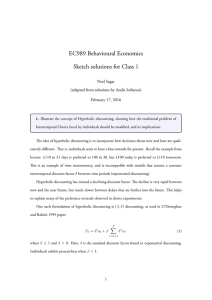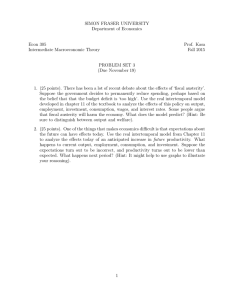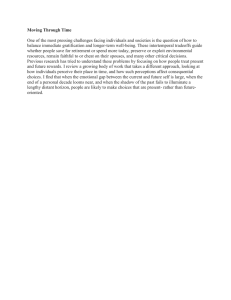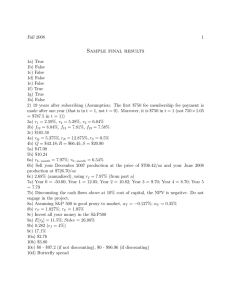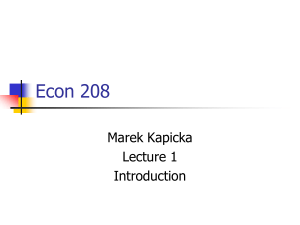Time and decision: introduction to the special issue
advertisement
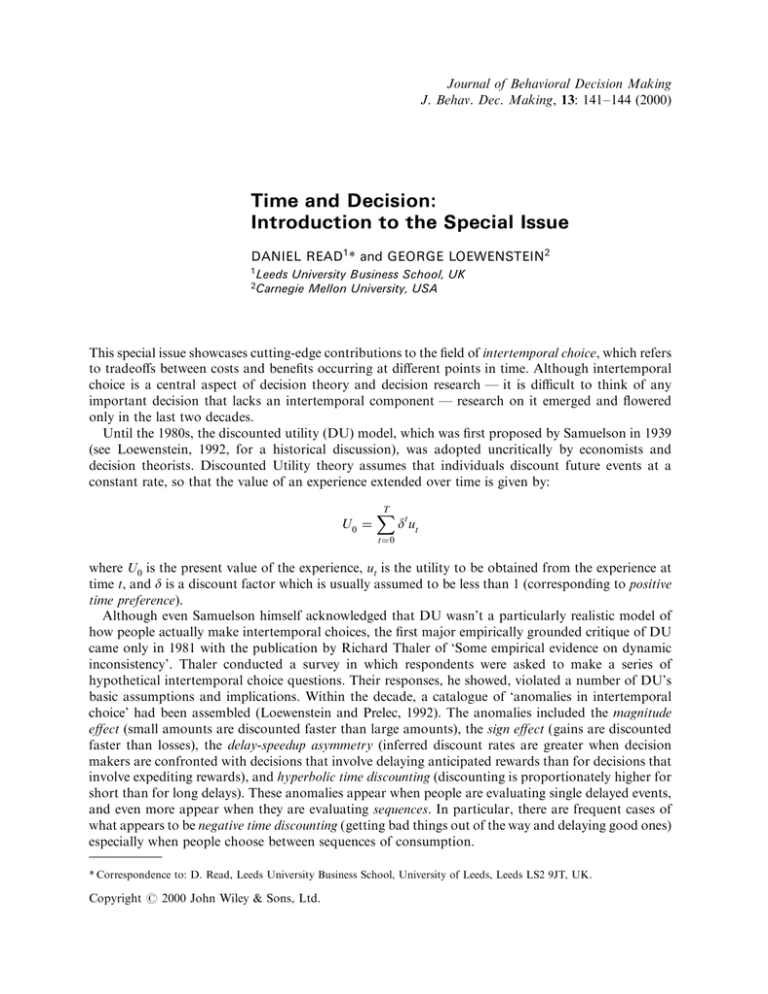
Journal of Behavioral Decision Making J. Behav. Dec. Making, 13: 141±144 (2000) Time and Decision: Introduction to the Special Issue DANIEL READ1* and GEORGE LOEWENSTEIN2 1 Leeds University Business School, UK Mellon University, USA 2Carnegie This special issue showcases cutting-edge contributions to the ®eld of intertemporal choice, which refers to tradeos between costs and bene®ts occurring at dierent points in time. Although intertemporal choice is a central aspect of decision theory and decision research Ð it is dicult to think of any important decision that lacks an intertemporal component Ð research on it emerged and ¯owered only in the last two decades. Until the 1980s, the discounted utility (DU) model, which was ®rst proposed by Samuelson in 1939 (see Loewenstein, 1992, for a historical discussion), was adopted uncritically by economists and decision theorists. Discounted Utility theory assumes that individuals discount future events at a constant rate, so that the value of an experience extended over time is given by: U0 T X t0 t d ut where U0 is the present value of the experience, ut is the utility to be obtained from the experience at time t, and d is a discount factor which is usually assumed to be less than 1 (corresponding to positive time preference). Although even Samuelson himself acknowledged that DU wasn't a particularly realistic model of how people actually make intertemporal choices, the ®rst major empirically grounded critique of DU came only in 1981 with the publication by Richard Thaler of `Some empirical evidence on dynamic inconsistency'. Thaler conducted a survey in which respondents were asked to make a series of hypothetical intertemporal choice questions. Their responses, he showed, violated a number of DU's basic assumptions and implications. Within the decade, a catalogue of `anomalies in intertemporal choice' had been assembled (Loewenstein and Prelec, 1992). The anomalies included the magnitude eect (small amounts are discounted faster than large amounts), the sign eect (gains are discounted faster than losses), the delay-speedup asymmetry (inferred discount rates are greater when decision makers are confronted with decisions that involve delaying anticipated rewards than for decisions that involve expediting rewards), and hyperbolic time discounting (discounting is proportionately higher for short than for long delays). These anomalies appear when people are evaluating single delayed events, and even more appear when they are evaluating sequences. In particular, there are frequent cases of what appears to be negative time discounting (getting bad things out of the way and delaying good ones) especially when people choose between sequences of consumption. * Correspondence to: D. Read, Leeds University Business School, University of Leeds, Leeds LS2 9JT, UK. Copyright # 2000 John Wiley & Sons, Ltd. 142 Journal of Behavioral Decision Making Vol. 13, Iss. No. 2 The papers in this special issue represent recent contributions to the ongoing critique of DU. They include further empirical demonstrations that DU fails as a descriptive theory, a discussion of the theoretical implications of this failure, and some investigations of the social consequences of peoples' apparently irrational time preferences. Rachlin, Brown and Cross have two goals: to estimate the form of the individual discount function, and to determine whether intertemporal choice is a special case of decision making under risk. They use a novel procedure to estimate the discount function and ®nd that hyperbolic discounting is more plausible than exponential discounting. Rachlin et al.'s major goal, however, is to determine the psychological basis for time discounting. They investigate a question raised by many economists and psychologists: whether discounting occurs because the future is a gamble Ð we might not be around to enjoy future rewards, and can't be sure of receiving them if we are around Ð and therefore delayed outcomes are treated as risky outcomes. Consistent with this view, Rachlin et al. show that uncertainty and delay are empirically equivalent in that the same hyperbolic equation can account for both delay discounting and probability discounting. They leave open the question of whether the causal arrow goes from probability to delay, or in the reverse direction. Roelofsma and Read provide a direct test of one of the fundamental predictions of discounted utility theory: that choice between delayed outcomes will be transitive. Their subjects make pairwise choices between alternatives composed of a delay and an amount. They ®nd the axiom of transivity is not supported by the data, and suggest that, when choosing between delayed outcomes, people compare the alternatives dimension by dimension. Usually, they compare the amounts ®rst, and turn to a comparison of delays if they don't dier signi®cantly. Just as Rachlin et al. draw a link between probability and time, so does this study, which is an extension of Amos Tversky's (1969) well-known study which demonstrated intransitivity in choices between gambles. Based on Lovallo and Kahneman's paper we might conclude that it is our concept of utility, and not of time discounting, that needs to be updated. Their study is part of a line of work arguing that one of the anomalies of intertemporal choice, the common desire to delay good outcomes and speed up bad ones, occurs because people dread anticipated negative events and look forward to (`savor') positive ones (Loewenstein, 1987). If these additional sources of pleasure and pain are incorporated into the utility function, then discounted utility can account for this apparent anomaly. They study when people want to resolve the outcomes of gambles. Some gambles have only positive outcomes, some have negative ones, and others are mixed. Consistent with the savoring and dread hypothesis, people are more willing to delay the resolution of positive gambles (which they like) than negative ones (which they dislike). Lovallo and Kahneman's contribution is based on the notion that the utility of an experience is in¯uenced by how we think of it outside of the brief period of its nominal occurrence. This is also the underlying insight of research into sequence eects in intertemporal choice. A sequence of events can have emergent properties, so that its overall value may not correspond to the summed value of the individual events if they are taken separately. Ariely and Carmon review what we know about these emergent properties, and show that a number of features determine the overall value that we place on speci®c sequences, in particular the intensity of the experience at its peak and at its end (Kahneman et al., 1993) and the rate of improvement or decline over the sequence. Both Ariely and Zauberman and Chapman deal with the latter feature. Chapman considers the fact that, under many circumstances, if people are asked how they would like to have a set of outcomes that vary in their immediate utility distributed over time, they will want them to be distributed in ascending order of utility, with the worst outcomes ®rst, and the best last. The preference for improving sequences seem to arise from reference-point eects. One proposal is that when things are getting better, each experience can be favorably compared with its predecessor and this favorable comparison is itself a source of utility (Loewenstein and Sicherman, 1991). Chapman Copyright # 2000 John Wiley & Sons, Ltd. Journal of Behavioral Decision Making, Vol. 13, 141±144 (2000) D. Read and G. Loewenstein Introduction 143 modi®es this formulation by proposing that people generally desire sequences that are similar to, but possibly somewhat more rapidly improving than, the one they think is normal, or the one they expect. Ariely and Zauberman also show that people like improving outcomes, but their main concern is in determining the circumstances under which people actually perceive a set of outcomes as a sequence, and when they perceive them as individual events. They investigate retrospective evaluations of sets of real events: sequences of aversive noise and investment outcomes. They ®nd that if a sequence is segmented, either by presenting it as ®ve separate bursts, or by requiring subjects to consider each outcome separately, then the preference for improvement over time becomes markedly reduced. All these empirical contributions test the limits of conventional discounting models. For such psychological studies to be taken seriously by economists, they must be shown a clear way of integrating these ®ndings with their theories. Researchers will stay with their old models until the usefulness of new ones is demonstrated, much in the same way that many farmers had to see demonstrations of hybrid corn varieties being planted and harvested before they switched themselves. That is, new models will have little impact unless a more descriptively realistic approach can be shown to be tractable and applicable to economic problems. This is exactly what Ted O'Donaghue and Matthew Rabin seek to do for hyperbolic time discounting. They draw out some economic implications of a hyperbolic discount function that puts disproportionate weight on immediate outcomes relative to delayed ones. Of particular interest is their distinction between `sophisticates' and `naifs'. Sophisticates are decision makers who know that they will have self-control problems in the future, and plan accordingly. Naifs are those who believe that they will have no such problems. It is not surprising that sophisticates are usually better o (they can act to forestall future lapses), but it is surprising that it is sometimes better to be naõÈ ve. You will have to turn to the article for a complete discussion, but the bottom line is that those who are optimistic about their level of self-control (i.e. they are naõÈ ve) are sometimes willing to wait for a better outcome than they eventually get, while those who know that they will break down eventually might just throw in the towel and break down right now. Chesson and Viscusi are concerned less with the theory of choice over time, and more with dierences in discount rates for members of dierent populations. Their method for estimating individual discount rates is ingenious and easy to apply, and is likely to be widely adopted by survey researchers. Some of their results run contrary to common intuitions about time discounting. For example, they ®nd that more educated people have higher discount rates than the less educated, that non-smokers have higher rates than smokers, and that older people have higher rates than younger. At a minimum, such ®ndings suggest that there is useful work to be done in the exploration and explanation of group dierences in time preference. Another noteworthy aspect of their paper is that the discount rates they obtain are much more reasonable (i.e., smaller) than those often obtained in studies of intertemporal choice. Whereas many studies observe implied rates of upwards of 100% per year (e.g. Kirby, 1997; Thaler, 1981), Chesson and Viscusi estimate rates typically less than 10%. Perhaps the most signi®cant domain in which the psychology of intertemporal preferences can be applied are those of addiction and choices concerning health. The special issue ends with an exchange between Paul Slovic and Kip Viscusi, who pull no punches when expressing their diering views. The topic is one of great applied interest: do people who begin smoking understand the consequences of their decisions, or are they naõÈ ve about what they are doing? Slovic's paper is both a critique of earlier writings by Viscusi and an empirically based argument that people do not make fully informed decisions when they begin to smoke, and that smokers underweight the consequences. Slovic's empirical work is based on people making qualitative measures of the risks they face. They are asked whether they believe that each additional cigarette will have a signi®cant eect on their future health, and it turns out that smokers are less likely to believe this than are non-smokers, and that this probability increases with the amount smoked. Viscusi argues that smokers and non-smokers alike greatly overestimate the risks from smoking when they are asked to make quantitative judgements of Copyright # 2000 John Wiley & Sons, Ltd. Journal of Behavioral Decision Making, Vol. 13, 141±144 (2000) 144 Journal of Behavioral Decision Making Vol. 13, Iss. No. 2 that risk, and therefore that it is not the failure to understand risks that dierentiates between smokers and non-smokers. Slovic counters by arguing (among other things) that although smokers may make realistic estimates of the risk to other people, they are overly optimistic about what will happen to them. We do not think the debate is over yet. We believe that the articles in this special issue represent the state of the art in behavioral decision research on intertemporal choice. Although it may sometimes make sense to delay good experiences so as to savor them, any further distraction from the papers themselves, would probably be a mistake. REFERENCES Kahneman, D., Fredrickson, B. L., Schreiber, C. A. and Redelmeier, D. A. `When more pain is preferred to less: Adding a better end', Psychological Science, 4 (1993), 401±405. Kirby, K. K. `Bidding on the future; evidence against normative discounting of delayed rewards', Journal of Experimental Psychology: General, 126 (1997), 54±70. Loewenstein, G. `Anticipation and the valuation of delayed consumption', Economic Journal, 97 (1987), 666±684. Loewenstein, G. `The fall and rise of psychological explanation in the economics of intertemporal choice', in Loewenstein, G. and Elster, J. (eds), Choice over time, New York: Russell Sage, 1992. Loewenstein, G. and Prelec, D. `Anomalies in intertemporal choice: Evidence and an interpretation', Quarterly Journal of Economics, (1992), 573±597. Loewenstein, G. and Sicherman, N. `Do workers prefer increasing wage pro®les?', Journal of Labor Economics, 9 (1991), 67±84. Strotz, R. H. `Myopia and inconsistency in dynamic utility maximization', Review of Economic Studies, 23 (1956), 165±180. Thaler, R. H. `Some empirical evidence on dynamic inconsistency', Economic Letters, 8 (1981), 201±207. Tversky, A. `Intransitivity of preferences', Psychological Review, 76 (1969), 31±48. Copyright # 2000 John Wiley & Sons, Ltd. Journal of Behavioral Decision Making, Vol. 13, 141±144 (2000)

